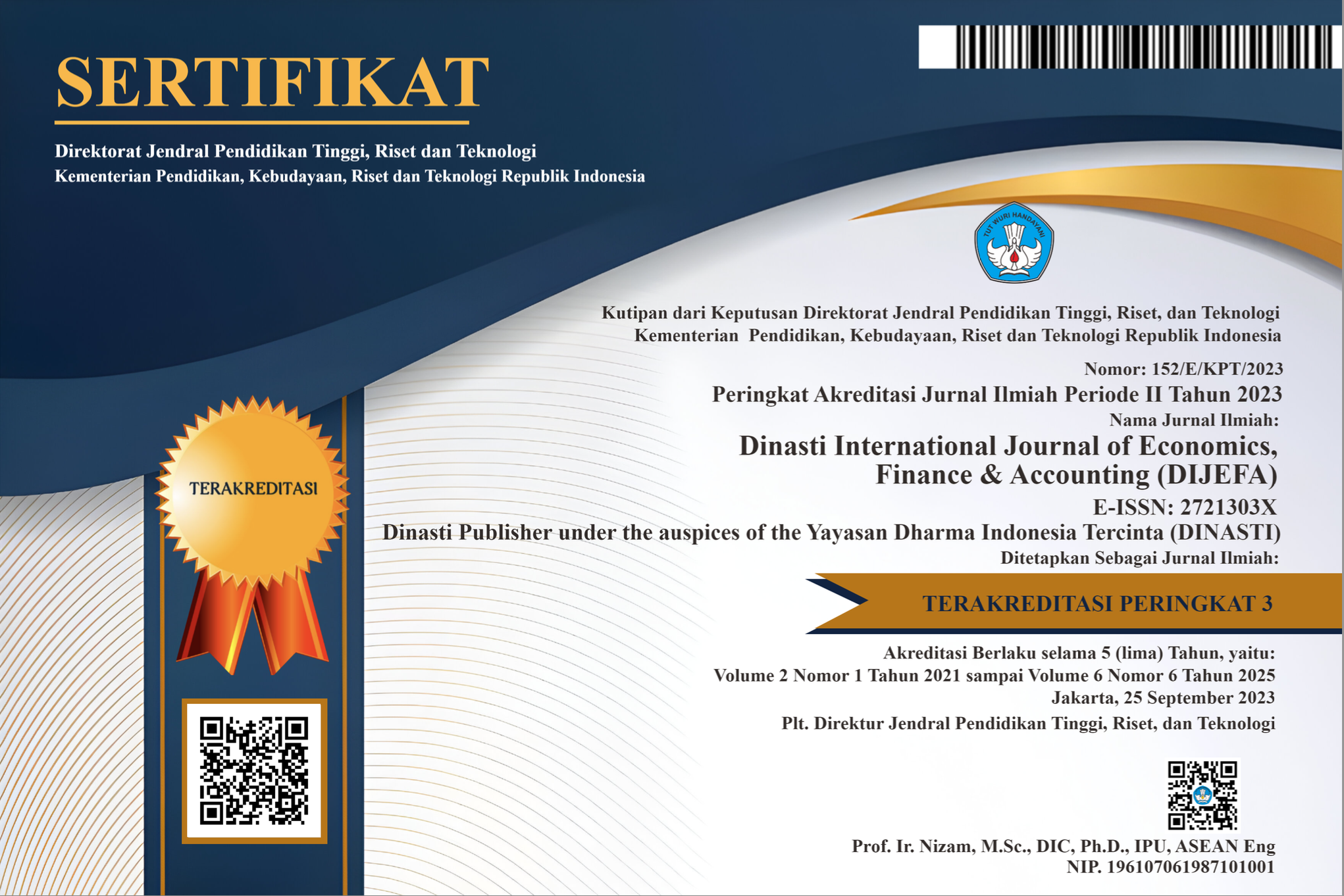Comparison Analysis of Peer-to-Peer Lending Performance During COVID-19 Activity Restrictions in Indonesia
DOI:
https://doi.org/10.38035/dijefa.v5i5.2840Keywords:
Loan Default, Loan Disbursment, Peer-to-peer lending, Covid-19Abstract
In recent years the peer-to-peer lending industry has been popular and growing in Indonesia, however activity restrictions due to Covid 19 had an impact on the global economy, especially on financial institutions including peer-to-peer lending. The Indonesian government has determined activity restrictions due to Covid-19 in March 2020 and activity restrictions will be lifted in December 2023. Researchers conducted an analysis to see the stability of peer-to-peer lending by comparing performance data of peer-to-peer lending companies through loan default and the number of loan distributions in the period before, during and after there were no restrictions on Covid 19 activities. The sample in this study used a purposive sampling technique of 72 samples of monthly peer-to-peer lending statistical data that had been registered and supervised by Otoritas Jasa Keuangan in 2018-2023, research was conducted using the General Linear Model Repeated Measure Test and the Friedman Test to determine whether there were significant differences between the three groups, namely the period before, during and after there were no restrictions on Covid 19 activities. The results of the analysis showed that there were significant differences in the loan default statistical values between the group before and during restrictions, the group after and during the Covid 19 pandemic restrictions with p values respectively 0.012 and 0.005. The average amount of loan disbursement has increased every year, but it was found that there was no significant difference between conditions before and during the Covid-19 pandemic restrictions.
References
Anh, N. T. T., Hanh, P. T. M., & Le Thu, V. T. (2021). Default in the US peer-to-peer market with covid-19 pandemic update: An empirical analysis from lending club platform. International Journal of Entrepreneurship, 25(7), 1–19.
Badan Pusat Statistik Indonesia. (2021). Ekonomi Indonesia 2020 Turun sebesar 2,07 Persen (c-to-c). https://www.bps.go.id/id/pressrelease/2021/02/05/1811/ekonomi-indonesia-2020-turun-sebesar-2-07-persen--c-to-c-.html
Butler, A. W., Cornaggia, J., & Gurun, U. G. (2017). Do Local Capital Market Conditions Affect Consumers’ Borrowing Decisions? Management Science, 63(12), 4175–4187. https://doi.org/10.1287/mnsc.2016.2560
Cumming, D. J., Martinez-Salgueiro, A., Reardon, R. S., & Sewaid, A. (2022). COVID-19 bust, policy response, and rebound: Equity crowdfunding and P2P versus banks. The Journal of Technology Transfer, 47(6), 1825–1846. https://doi.org/10.1007/s10961-021-09899-6
De Roure, C., Pelizzon, L., & Thakor, A. (2022). P2P Lenders versus Banks: Cream Skimming or Bottom Fishing? The Review of Corporate Finance Studies, 11(2), 213–262. https://doi.org/10.1093/rcfs/cfab026
Gagnon, J. E., Kamin, S. B., & Kearns, J. (2023). The impact of the COVID-19 pandemic on global GDP growth. Journal of the Japanese and International Economies, 68, 101258. https://doi.org/10.1016/j.jjie.2023.101258
Hughes, J. P., Jagtiani, J., & Moon, C.-G. (2022). Consumer lending efficiency: Commercial banks versus a fintech lender. Financial Innovation, 8(1), 38. https://doi.org/10.1186/s40854-021-00326-1
Lin, X., Li, X., & Zheng, Z. (2017). Evaluating borrower’s default risk in peer-to-peer lending: Evidence from a lending platform in China. Applied Economics, 49(35), 3538–3545. https://doi.org/10.1080/00036846.2016.1262526
Louise, L., & Yanuar, Y. (2022). Pengaruh Covid-19 terhadap Pertumbuhan Fintech Pinjaman di Indonesia. Jurnal Manajemen Bisnis Dan Kewirausahaan, 6(3), 283. https://doi.org/10.24912/jmbk.v6i3.18660
Nigmonov, A., & Shams, S. (2021). COVID-19 pandemic risk and probability of loan default: Evidence from marketplace lending market. Financial Innovation, 7(1), 83. https://doi.org/10.1186/s40854-021-00300-x
Situmorang, K., Siregar, H., Zulbainarni, N., & Sembel, R. H. M. (2023). Performance Mapping Of Fintech Peer To Peer Lending (P2PL) in Indonesia. Jurnal Aplikasi Bisnis Dan Manajemen (JABM), 9(2), Article 2. https://doi.org/10.17358/jabm.9.2.501
Subagia, I., & Effendi, K. A. (2023). Analisis Pertumbuhan Fintech Sebelum dan Saat Pandemi Covid-19 di Indonesia. Owner, 7(4), 3052–3062. https://doi.org/10.33395/owner.v7i4.1668
Taujanskait?, K., & Mil?ius, E. (2022). Accelerated Growth of Peer-to-Peer Lending and Its Impact on the Consumer Credit Market: Evidence from Lithuania. Economies, 10(9), 210. https://doi.org/10.3390/economies10090210
WHO. (2024). Timeline: WHO’s COVID-19 response. https://www.who.int/emergencies/diseases/novel-coronavirus-2019/interactive-timeline
Yu, Z., Razzaq, A., Rehman, A., Shah, A., Jameel, K., & Mor, R. S. (2022). Disruption in global supply chain and socio-economic shocks: A lesson from COVID-19 for sustainable production and consumption. Operations Management Research, 15(1–2), 233–248. https://doi.org/10.1007/s12063-021-00179-y
Downloads
Published
How to Cite
Issue
Section
License
Copyright (c) 2024 Abdul Robby Farhan, Rofikoh Rokhim

This work is licensed under a Creative Commons Attribution 4.0 International License.
Authors who publish their manuscripts in this journal agree to the following conditions:
- The copyright on each article belongs to the author(s).
- The author acknowledges that the Dinasti International Journal of Economics, Finance & Accounting (DIJEFA) has the right to be the first to publish with a Creative Commons Attribution 4.0 International license (Attribution 4.0 International (CC BY 4.0).
- Authors can submit articles separately, arrange for the non-exclusive distribution of manuscripts that have been published in this journal into other versions (e.g., sent to the author's institutional repository, publication into books, etc.), by acknowledging that the manuscript has been published for the first time in the Dinasti International Journal of Economics, Finance & Accounting (DIJEFA).


























































